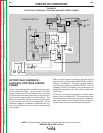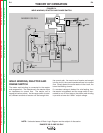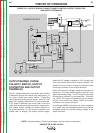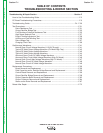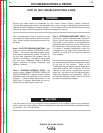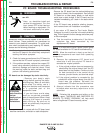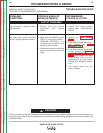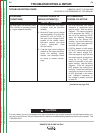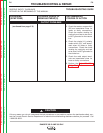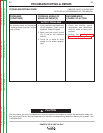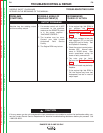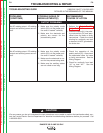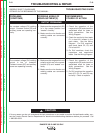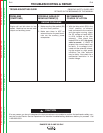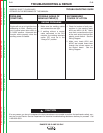
Return to Section TOC Return to Section TOC Return to Section TOC Return to Section TOC
Return to Master TOC Return to Master TOC Return to Master TOC Return to Master TOC
TROUBLESHOOTING & REPAIR
F-5 F-5
RANGER 300 D AND 300 DLX
TROUBLESHOOTING GUIDE OBSERVE SAFETY GUIDELINES
DETAILED IN THE BEGINNING OF THIS MANUAL.
CAUTION
If for any reason you do not understand the test procedures or are unable to perform the test/repairs safely, con-
tact the Lincoln Electric Service Department for electrical troubleshooting assistance before you proceed. Call
1-800-833-9353.
PROBLEMS
(SYMPTOMS)
POSSIBLE AREAS OF
MISADJUSTMENT(S)
RECOMMENDED
COURSE OF ACTION
OUTPUT PROBLEMS
No weld output, the auxiliary power
(230-115VAC) is operating normal-
ly. Engine operates normally.
1. On DLX machines, the output
contactor must be activated
(closed).
2. Normal AC open circuit voltage
is approximately 70 to 80 volts.
Normal DC is 64 to 74VDC. If
the open circuit voltage is NOT
present at the welder output
terminals, contact your local
Lincoln Authorized Field
Service Facility.
3. If normal open circuit voltage is
present at the output terminals,
check the welding cables,
clamps, and electrode holder
for loose or broken connec-
tions.
1. On DLX machines, the output
contactor or associated leads
may be faulty. See the Wiring
Diagram. The output contactor
coil is energized by 12VDC. If
the coil is not receiving 12VDC
when the Welding Terminals
Switch is in the “Always ON”
position, the control board may
be faulty. Also check associat-
ed leads #224 and #232.
2. If OCV is absent in both modes
(CV & CC), disconnect lead W1
from the output bridge (D1).
With the engine at high idle and
the output control at maximum,
check for 70 to 76VAC from
lead W1 to lead W2 on the main
stator winding. See the Wiring
Diagram. If the AC voltage is
NOT present, the winding may
be faulty. Check the winding for
continuity and test to be sure it
is NOT grounded to the stator
iron. Replace if necessary. If
the voltage is present, proceed
to step #3.
(continued on page F-6)



